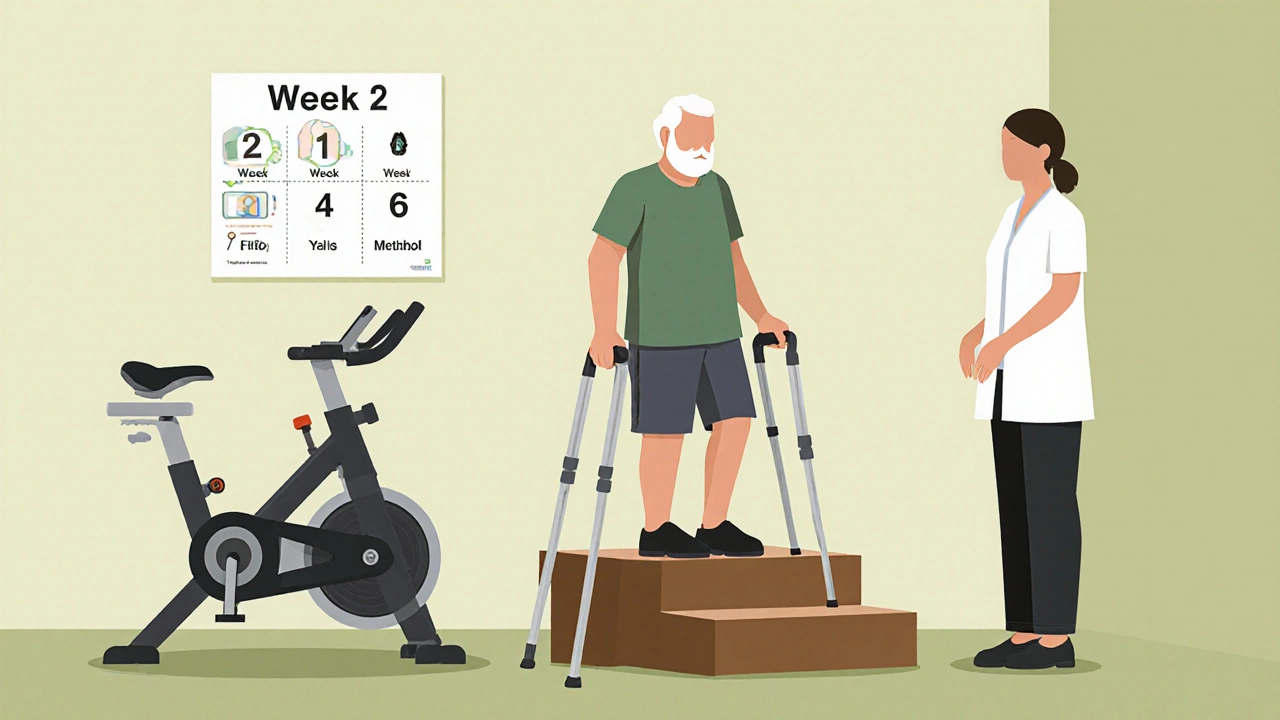
Quick Takeaways
- Most patients start short, assisted walks within the first 24‑48 hours.
- Independent strolling without a cane typically emerges around 6‑8 weeks.
- Full‑speed, long‑distance walking may take 3‑4 months, depending on age, health and rehab effort.
- Sticking to a prescribed physical‑therapy plan is the single biggest factor that speeds up recovery.
- Watch for warning signs like swelling, persistent pain or instability - they may signal complications.
When you hear the phrase knee replacement recovery time, you probably picture a long, painful healing road. In reality, the journey is a series of small, measurable steps. Below we break down the typical timeline, the variables that can speed it up or slow it down, and practical tips to get you walking normally as soon as safely possible.
Understanding Knee Replacement
Knee replacement is a surgical procedure that swaps out damaged joint surfaces with artificial implants, restoring alignment and relieving pain. It is also called total knee arthroplasty (TKA) and is one of the most common orthopedic operations worldwide.
Typical Hospital Stay and First Steps
After the surgeon closes the incision, you’ll stay in the hospital for 1‑3 days. The first goal is to get you out of bed and moving. Within a few hours, a physical therapist (PT) will guide you through gentle ankle pumps, straight‑leg raises and the first assisted steps using a walker or crutches.
Early movement isn’t just about comfort - it reduces the risk of blood clots, improves circulation, and jump‑starts the healing of the joint capsule.
Early Rehab: Days 1‑7
During the first week, the focus is on pain control, swelling management and basic gait training. Expect the following milestones:
- Day 1‑2: Sit up, stand, and take a few steps with a walker. You’ll likely use a knee brace that limits flexion to 90°.
- Day 3‑4: Transition from a walker to crutches as balance improves.
- Day 5‑7: Begin light stationary‑bike sessions (no resistance) to promote range of motion.
Most patients report being able to walk 50‑100 meters with assistance by the end of week one.

Walking Milestones: Weeks 2‑6
From the second week onward, the rehab program intensifies. The surgeon will usually clear you for a knee brace (if used) to be removed, allowing you to bend the knee beyond 90°.
Typical progress looks like this:
| Timeframe | Goal | Typical Walking Ability |
|---|---|---|
| Week 2 | Full weight‑bearing, start stair training | Assisted walk <5m with crutches |
| Week 4 | Improve range of motion to 110°-120° | Unaided short walks <20m, may still use a cane |
| Week 6 | Strengthen quadriceps and hamstrings | Independent walking <100m, transition to normal shoes |
At the six‑week mark, many patients feel comfortable walking without any device for everyday errands, though they might still avoid long distances or uneven terrain.
When Can You Walk Normally?
“Normal walking” usually means a smooth, pain‑free gait at a comfortable speed without assistive devices. For most people, this arrives between 8 and 12 weeks post‑op, provided the rehab plan is followed and there are no setbacks.
Long‑distance or high‑impact activities (marathons, hiking) often need 3‑4 months of focused conditioning. The implant itself is designed to handle regular walking loads indefinitely, but the surrounding muscles and tendons need time to regain strength.
Factors That Speed Up or Slow Down Recovery
Not everyone follows the same timeline. Here are the biggest variables:
- Age: Younger patients (under 65) generally rebuild muscle faster.
- Pre‑surgery fitness: Those who exercised before surgery often regain range of motion quicker.
- Weight: Higher body‑mass index can increase joint stress and slow progress.
- Medical comorbidities: Diabetes, arthritis in other joints, or cardiovascular disease may extend healing.
- Rehab adherence: Skipping PT sessions or doing exercises incorrectly is the single biggest delay factor.
- Complications: Infection, blood clots, or prosthesis misalignment require additional treatment and postpone walking milestones.

Tips to Support Faster Walking
These practical actions can shave weeks off your timeline:
- Start gentle ankle pumps and leg lifts the night before surgery - your muscles remember the motion.
- Follow the surgeon’s pain‑management plan. Uncontrolled pain makes you avoid movement.
- Use ice packs for 20 minutes, three times daily, to limit swelling.
- Attend every PT session and ask for a home‑exercise handout; consistency beats intensity.
- Wear a supportive, low‑heeled shoe with a firm sole once cleared - it promotes a smoother gait.
- Stay hydrated and eat protein‑rich foods to aid tissue repair.
Common Pitfalls to Avoid
Even with the best plan, certain habits can trip you up:
- Relying on pain medication alone and staying sedentary.
- Skipping the first week of walking because “it hurts”. Early motion reduces scar tissue.
- Using a walker for longer than needed - it can weaken the leg muscles.
- Ignoring swelling; if the knee feels “tight”, gently flex it every few hours.
- Returning to high‑impact sports before the 4‑month mark - this raises the risk of early wear.
Frequently Asked Questions
How soon after surgery can I put weight on my new knee?
Most surgeons encourage partial weight‑bearing with a walker or crutches within the first few hours. Full weight‑bearing usually starts on day two or three, depending on pain tolerance and intra‑operative findings.
Is it normal to feel stiffness after the first month?
Yes. The joint capsule and surrounding muscles need time to adapt. Regular gentle stretching, as guided by your PT, usually loosens the stiffness by week six.
Can I use a stationary bike right away?
A low‑resistance bike is often introduced on day three or four. It helps improve range of motion without loading the joint heavily.
What are the warning signs of a complication?
Rapid swelling, increasing redness, fever above 38°C, or a feeling that the knee is unstable should trigger an immediate call to your surgeon.
Will I need a second surgery later?
Modern implants last 15‑20 years on average. Revision surgery is rarely needed unless there’s infection, loosening, or severe trauma.





